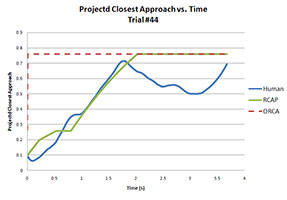



Real Humans and RCAP agents
(In free space, and near a wall)
Between Real Humans and RCAP agents

|

|

|

|
||
|
Experimental Setup & Paths Real Humans and RCAP agents |
Time-Lapse Image of 2 Agents Exchanging Locations (In free space, and near a wall) |
Comparison of Point-of-Closest-Approach Between Real Humans and RCAP agents |
Abstract: We present RCAP, a new trajectory planning algorithm for virtual humans. Our approach focuses on implicit cooperation between multiple virtual agents in order to share the work of avoiding collisions with each other. Specifically, we extend recent work on multi-robot planning to better model how humans avoid collisions by introducing new parameters that model human traits, such as reaction time and biomechanical limitations. We validate this new model based on data of real humans walking captured by the Locanthrope project. We also show how our model extends to complex scenarios with multiple agents interacting with each other and avoiding nearby obstacles.
Videos:
AAMAS Paper: [PDF]